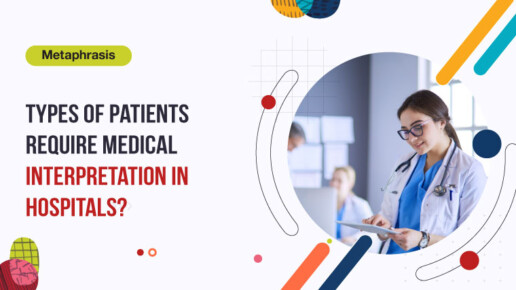Types of Patients Require Medical Interpretation in Hospitals?
Introduction to Medical Interpretation
In the diverse landscape of healthcare, effective communication is paramount. However, language barriers often pose significant challenges, hindering the delivery of quality care. Medical interpretation in Hospitals emerges as a crucial solution to bridge this gap, ensuring that patients receive comprehensive and accurate information regardless of their language proficiency.
Language Barriers in Healthcare
Importance of Effective Communication
Effective communication is the cornerstone of healthcare delivery. It not only fosters mutual understanding between healthcare providers and patients but also ensures informed decision-making and patient safety.
Challenges Faced Due to Language Barriers
Language barriers can lead to misunderstandings, errors in diagnosis, inappropriate treatment, and compromised patient outcomes. Such challenges intensify in multilingual healthcare settings where patients and providers speak different languages.
Who Are Medical Interpreters?
Medical interpreters play a pivotal role in facilitating communication between healthcare providers and patients with limited English proficiency (LEP) or other communication barriers.
Role and Responsibilities
Medical interpreters accurately convey medical information, ensuring that patients comprehend diagnoses, treatment options, medication instructions, and consent forms. Metaphrasis serve as impartial conduits, preserving the confidentiality and integrity of healthcare interactions.
Qualifications and Training
Qualified medical interpreters possess linguistic proficiency, cultural competence, and specialized training in medical terminology and ethics. Certification programs and ongoing professional development ensure their competence and adherence to industry standards.
Types of Patients Requiring Medical Interpretation
Patients with Limited English Proficiency (LEP)
Patients with limited English proficiency constitute a significant demographic requiring medical interpretation services. They may struggle to articulate their symptoms, medical history, or concerns, impeding accurate diagnosis and treatment.
Deaf or Hard of Hearing Patients
Deaf or hard of hearing patients rely on sign language interpreters to facilitate communication during medical consultations, procedures, or hospital stays. Effective communication ensures their autonomy, dignity, and access to healthcare services.
Patients with Limited Literacy Skills
Patients with limited literacy skills may face challenges in understanding written medical materials, such as discharge instructions, medication labels, or health education materials. Verbal interpretation helps them comprehend and adhere to treatment regimens effectively.
Patients with Cognitive Impairments
Patients with cognitive impairments, such as dementia or developmental disabilities, may struggle to communicate their symptoms, preferences, or consent. Medical interpreters play a crucial role in ensuring their rights, safety, and quality of care.
Patients from Diverse Cultural Backgrounds
Patients from diverse cultural backgrounds may have unique beliefs, practices, or health-seeking behaviors that influence their healthcare experiences. Culturally competent interpretation fosters trust, respect, and mutual understanding between patients and providers.
Benefits of Medical Interpretation
Medical interpretation yields multifaceted benefits for patients, healthcare providers, and healthcare systems.
Improved Patient Care
Accurate communication enhances patient comprehension, engagement, and adherence to treatment plans, leading to better health outcomes and reduced medical errors.
Enhanced Patient Satisfaction
Patients appreciate receiving care in their preferred language, which promotes trust, satisfaction, and positive healthcare experiences. Effective communication fosters patient-centered care and strengthens patient-provider relationships.
Legal and Ethical Considerations
Federal and state laws mandate language access for LEP patients to ensure equitable healthcare delivery and compliance with civil rights protections. Providing medical interpretation services aligns with ethical imperatives to uphold patient rights, dignity, and safety.
Methods of Medical Interpretation
Various modalities of medical interpretation cater to diverse patient needs and healthcare settings.
In-person Interpretation
In-person interpretation involves a qualified interpreter who accompanies patients during medical appointments, consultations, or hospitalizations. It allows for nuanced communication, rapport building, and nonverbal cues.
Telephone Interpretation
Telephone interpretation offers on-demand language support, enabling rapid access to interpreters for urgent or remote consultations. It enhances flexibility, efficiency, and cost-effectiveness in healthcare delivery.
Video Remote Interpretation (VRI)
Video remote interpretation facilitates real-time communication between patients and providers via video conferencing platforms. It combines the benefits of in-person and telephone interpretation, offering visual cues and linguistic support.
Challenges in Providing Medical Interpretation Services
Despite the benefits, several challenges persist in ensuring equitable access to medical interpretation services.
Availability of Qualified Interpreters
Shortages of qualified interpreters, especially in languages other than English, pose significant barriers to timely and effective communication. Rural areas and underserved communities often face limited access to trained professionals.
Cost and Resource Constraints
Funding constraints and reimbursement limitations may hinder healthcare organizations’ ability to invest in robust interpretation services. Balancing quality, affordability, and sustainability remains a constant challenge.
Maintaining Confidentiality
Safeguarding patient privacy and confidentiality is paramount in medical interpretation. Ensuring secure communication channels, data encryption, and adherence to HIPAA regulations is essential to protect sensitive health information.
Best Practices for Effective Medical Interpretation
Adhering to best practices ensures the quality, accuracy, and cultural responsiveness of medical interpretation services.
Preparation and Planning
Healthcare providers should assess patients’ language needs in advance and schedule interpretation services accordingly. Providing relevant materials in multiple languages and training staff in cross-cultural communication enhance preparedness.
Clear Communication
Interpreters should convey information accurately, without altering the meaning or tone of the message. Clarifying medical jargon, using plain language, and confirming patient understanding promote effective communication.
Cultural Sensitivity
Recognizing and respecting patients’ cultural norms, values, and preferences is essential for building trust and rapport. Interpreters should navigate linguistic and cultural nuances with sensitivity and humility.
Conclusion
Medical interpretation plays a vital role in ensuring equitable access to healthcare for linguistically and culturally diverse populations. By addressing language barriers, medical interpreters facilitate meaningful communication, enhance patient care, and uphold the principles of patient-centered care and healthcare equity.

